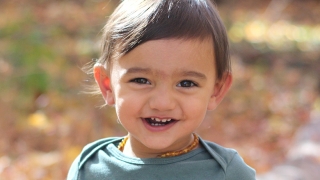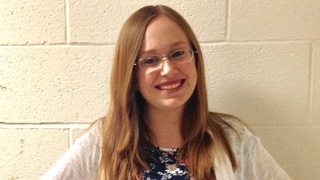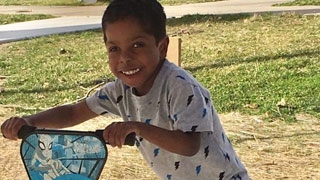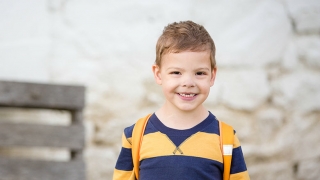Years before Alison and Philip Chandra became pregnant with their second child, they had chosen their favorite boy’s name: Ethan, which means strength. That strength was something they and their son would eventually need plenty of.
 When Alison was 25 weeks pregnant, she went to her obstetrician for a routine ultrasound. Because she’s a nurse, Alison knew something was wrong when the technician spent a lot of time looking at her baby’s heart. Sure enough, a doctor was summoned and Alison was immediately sent to a pediatric cardiologist for further tests.
When Alison was 25 weeks pregnant, she went to her obstetrician for a routine ultrasound. Because she’s a nurse, Alison knew something was wrong when the technician spent a lot of time looking at her baby’s heart. Sure enough, a doctor was summoned and Alison was immediately sent to a pediatric cardiologist for further tests.
By the end of the day, Alison had a diagnosis: Her baby had heterotaxy syndrome, a rare disorder in which some organs form on the wrong side of the body. Babies with this condition typically have various heart defects, too. Ethan was diagnosed with complex congenital heart disease (CHD), which included unbalanced complete AV canal, hypoplastic pulmonary annulus, and double outlet right ventricle.
At her local hospital in New Jersey, Alison remembers the cardiologist sitting her down and drawing a picture of her baby’s heart to illustrate the problems with his circulation. Because of Ethan’s diagnosis of heterotaxy syndrome and complex CHD, the cardiologist recommended that delivery be arranged at a hospital that specialized in the care and management of newborns with CHD, and where pediatric cardiac surgery services were available onsite.
Choosing CHOP
As the couple dealt with the news of their son’s condition, and considered the options of where to turn for care, they were faced with an additional challenge: Alison and Philip were physically separated by an ocean.
More About Heterotaxy Syndrome
For the previous six years, the Chandras had been volunteering aboard the Africa Mercy, the largest civilian hospital ship in the world. The ship travels along the coast of West Africa and provides medical care to the poor and medically underserved residents of those countries. At the time of their baby’s diagnosis, Philip was still abroad.
“When you work on the ship, you go home for maternity leave a few months before your due date and the father follows you two weeks or so before you’re due,” says Alison. The couple had followed this procedure less than two years before while pregnant with their daughter, Zoe. Though they had planned to return to the ship after Ethan’s birth, they quickly realized they’d need to start life on land instead.
It was her family’s personal tie to The Children’s Hospital of Philadelphia that quickly led the Chandras to consider CHOP. In 1983, her brother had had a ventricular septal defect repaired at the Hospital.
“My brother has been celebrating his heart day for 31 years, so I knew CHOP could fix hearts,” says Alison.
Finding hope at the Fetal Heart Program
Beginning with Alison’s first call to CHOP’s Fetal Heart Program, things began to fall into place.
“Each person I spoke with put me in touch with the exact person I needed to speak with next, from cardiologists to people in financial assistance,” says Alison. “I started out having no idea how to proceed and then suddenly things were happening on exactly the day they needed to.”
When she was 29 weeks pregnant, Alison traveled to Philadelphia for her first appointment with the team at the Fetal Heart Program. After her fetal echocardiogram, she met with cardiologist Christine Falkensammer, MD, the program’s clinical nurse coordinator Jill Combs, RN, MSN, and social worker Jennifer Diem-Inglis, LSW.
During that first visit, Alison also had an extensive ultrasound, and an MRI, followed by a consultation with the obstetrical team in CHOP’s Center for Fetal Diagnosis and Treatment.
Each year, CHOP sees around 20-25 unborn babies with heterotaxy syndrome who have complex CHD, which is more than most other hospitals in the United States. The Fetal Heart Program also performs around 3,700 fetal echocardiograms each year, giving the team vast experience in diagnosing complex heart conditions.
Despite the fact that Alison’s baby would be born with a variety of medical problems, the team at CHOP was able to offer Alison hope.
“At CHOP, everyone was saying they knew how to deal with kids like Ethan,” says Alison. “It was so encouraging!”
Regaining control during delivery
Over the following weeks, Alison made the trip from New Jersey to CHOP once a month for appointments with the Fetal Heart team, to monitor the growth of Ethan’s heart structures and to check on his heart function and rhythm.
At 38 weeks into her pregnancy, Alison, her mom, Zoe, and Philip, who had arrived in the United States a few week before, set up camp in Philadelphia. Two weeks later, Alison delivered Ethan in CHOP’s Garbose Family Special Delivery Unit (SDU).
“I have nothing but positive memories surrounding Ethan’s birth,” says Alison, who delivered naturally, with a midwife and Philip by her side. The SDU is right next to CHOP’s Cardiac Intensive Care Unit and cardiac operating rooms. Newborns in the SDU are in the hands of experts immediately after birth, and parents are able to stay close to their baby.
“We had been mourning so many things since finding out Ethan had heterotaxy, but delivering Ethan the way we wanted, in such a comfortable, peaceful setting — that gave us back some control and normalcy,” adds Alison.
Six days after he was born, Ethan underwent his first open heart surgery to adjust his circulation. Thomas L. Spray, MD, chief of the Division of Cardiothoracic Surgery, performed the procedure. Less than a week later, Ethan was discharged from the hospital, and before the end of the month, he was heading home with his family to New Jersey.
Planning for the future
 Over the last seven months, Ethan has been doing amazingly well. He was exclusively breastfed for the first six months, just started eating solids and is growing and meeting developmental milestones. He had his second surgery in November 2014 and only spent three days in the Hospital before being cleared to return home.
Over the last seven months, Ethan has been doing amazingly well. He was exclusively breastfed for the first six months, just started eating solids and is growing and meeting developmental milestones. He had his second surgery in November 2014 and only spent three days in the Hospital before being cleared to return home.
“Ethan had no postoperative issues. He’s gaining weight really well and is really active and social — there’s just no stopping him right now,” says cardiologist Sumekala Nadaraj, MD, who has been caring for Ethan since he returned home to New Jersey.
The Chandras see Dr. Nadaraj at CHOP’s Specialty Care, Pediatric Cardiology location at Saint Peter’s University Hospital in New Brunswick, NJ. The office is 25 miles from their home — a much shorter distance than the 95 miles to CHOP’s Main Campus. As Ethan’s pediatric cardiologist, Dr. Nadaraj works closely with her Cardiac Center colleagues who are part of Ethan’s care team.
“Ethan will need cardiac care for the rest of his life, and it’s nice to know he’ll be cared for by CHOP so close to home,” says Alison. “We’re making our lives on land now and planning for the future — and we fully expect Ethan to be a part of that future, thanks to CHOP.”
Originally published March 2015


